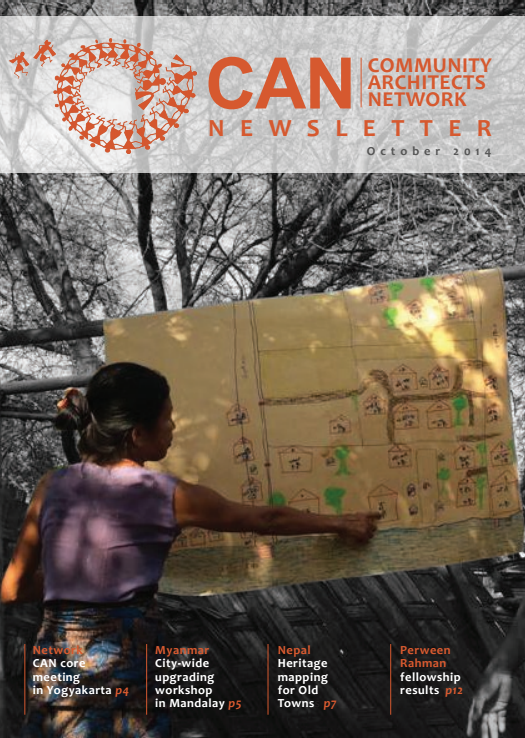 publications
publications
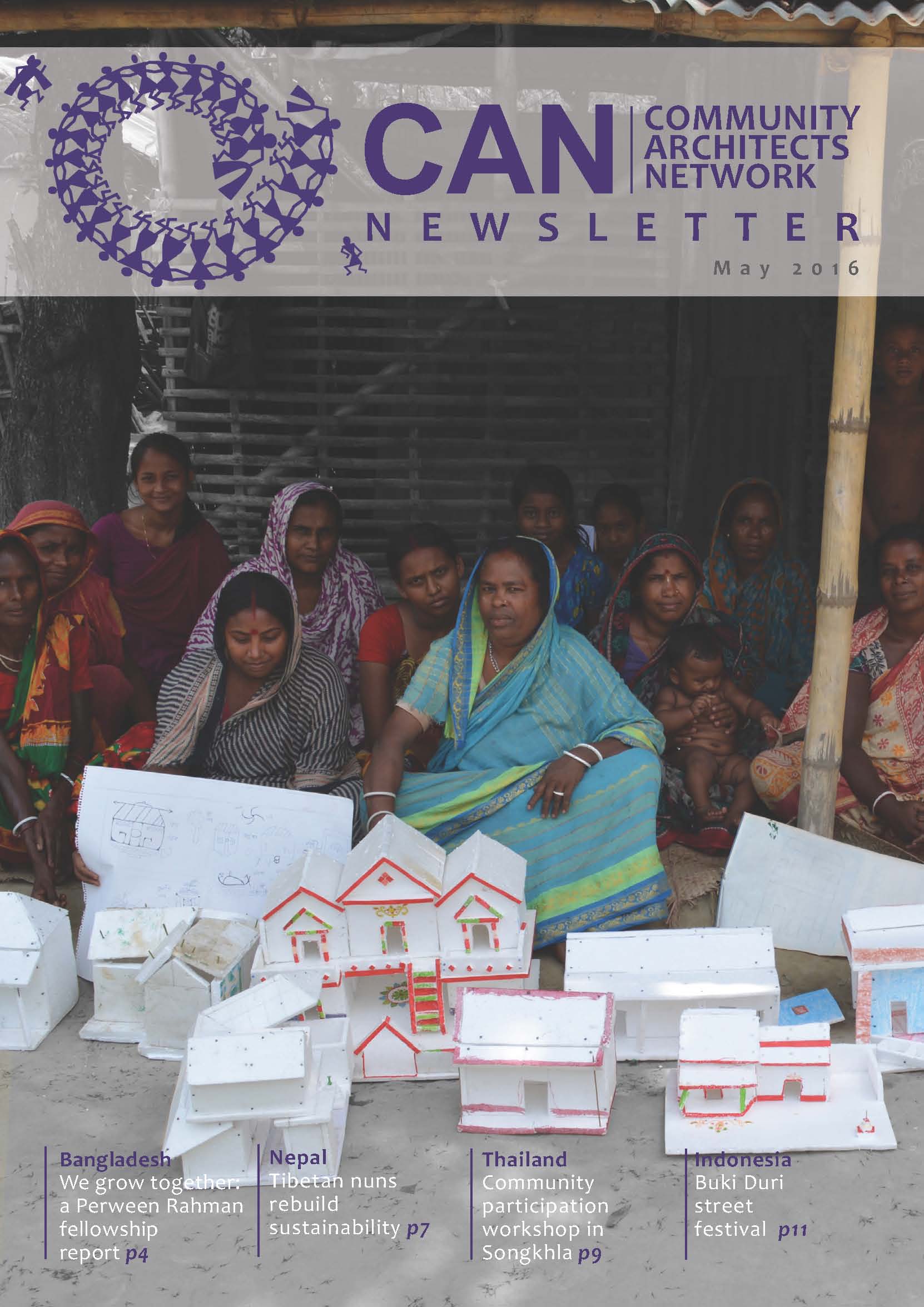
May 2016
CAN NEWSLETTER MAY 2016
Size: 5412MB
Happy Spring 2016! While CAN is proud to support Perween Rahman fellows for the 3rd year in a row, and ready to host a joint workshop with the DPU, UCL in Phnom Penh, Cambodia, under CAN CAM for the third year in a row, our network is about to enter a new, and uncertain phase. The 3-year funding provided by the German charity Misereor will close in July, and no funding has been secured yet for CAN activities in the future. The future of CAN, and where do we go from here? will be one of the main discussion topics this July, at CAN’s fourth regional workshop this year to be held in Bangkok. What can be done to assure CAN’s member groups in each country are self-suffient? How can we continue to network, and support each other financially, Inspirationally, and technically across countries?
At this particular moment of CAN’s evolution we are trying to paint the situation of community architecture within each country in the network, to compile experiences and skills of community architects all across Asia. Hopefully the short book will be ready to be distribute at the next regional workshop. If you are one of the countries who hasnt submitted material yet please do, so we can make this hope a reality!
At this particular moment of CAN’s evolution we are trying to paint the situation of community architecture within each country in the network, to compile experiences and skills of community architects all across Asia. Hopefully the short book will be ready to be distribute at the next regional workshop. If you are one of the countries who hasnt submitted material yet please do, so we can make this hope a reality!
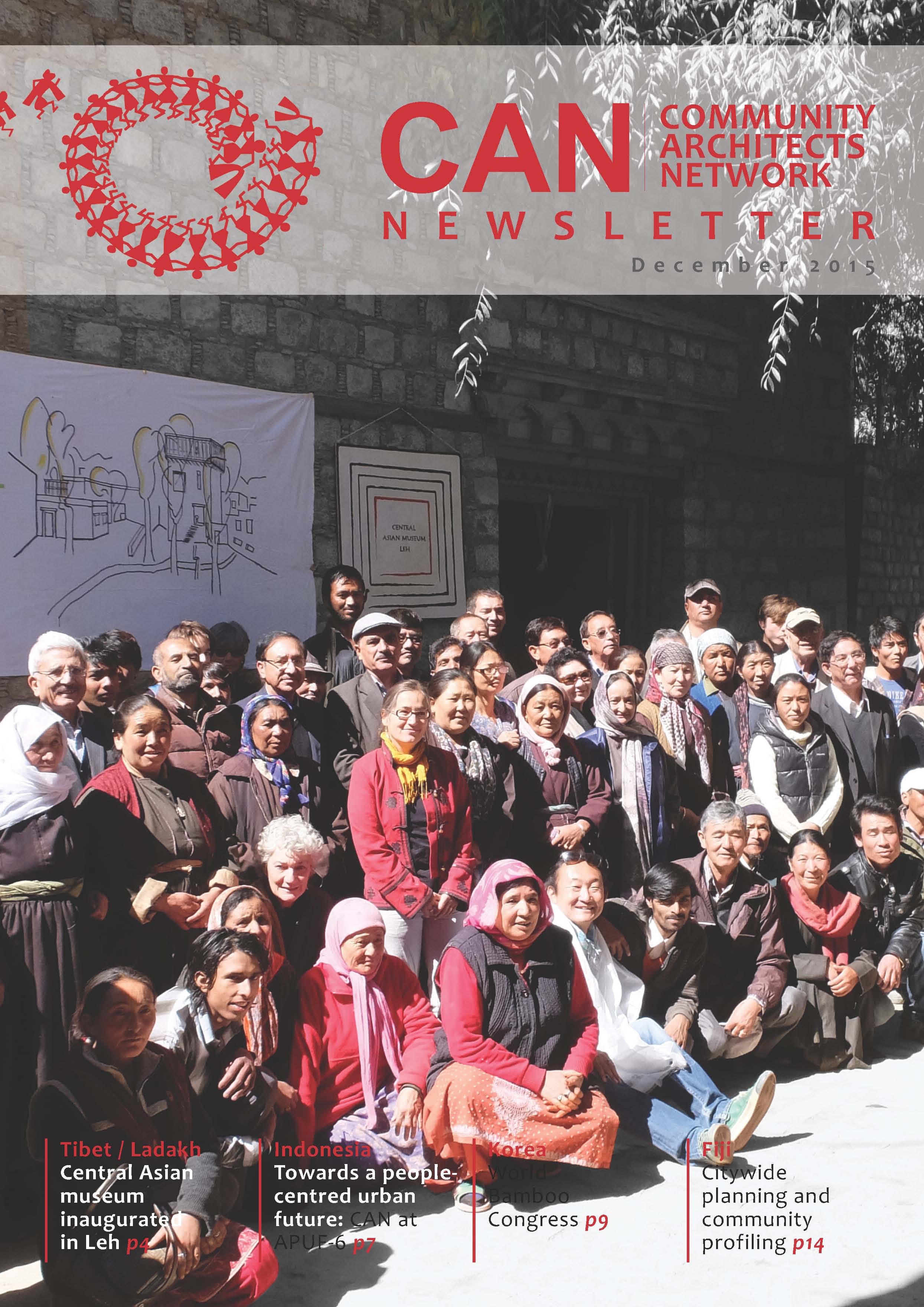
December 2015
CAN Newsletter December 2015
Size: 11944MB
This 5th CAN newsletter is a bamboo themed issue, bringing a number of inspiring stories on bamboo from Korea and Indonesia. Most significantly CAN’s presence at the international bamboo conference held in Korea this year, in which the CAN team went on a mini road show, presenting about participatory design at a number of venues. Also this fall, CAN and ACHR facilitated a parallel session on community-led design solutions at the Asian Pacific Urban Forum in October in Jakarta. On the other side of the world in New York, out of over 400 candidates, CAN was a finalist at the Buckminster Fuller Award ceremony. The Buckminster Fuller Challenge award gives a sizeable amount of money to supporting activities which bring a social and ecologically sustainable innovative solution to the worlds problems. The winner was a kelp farming initiative in the US for fisherman with increasing insecure livelihoods, and a runner up with CAN was the Manila Housing Authority in India, working with Slum Dwellers.
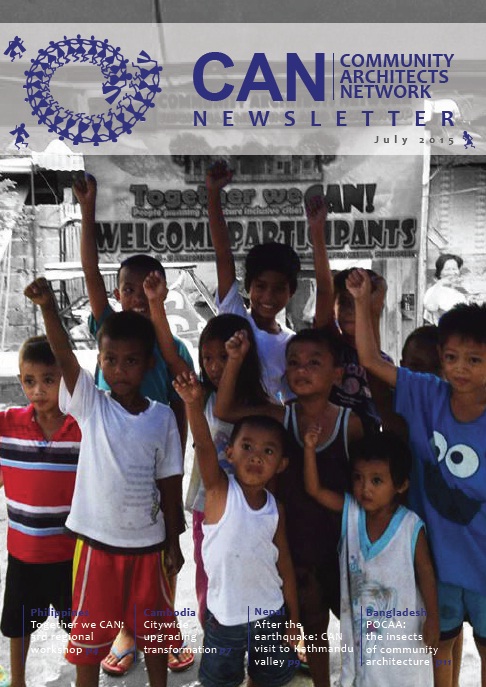
July 2015
CAN Newsletter July 2015
Size: 12452MB
In June the Phillipines hosted the 3rd CAN Regional workshop for the second edition in a row. Thank-you to all the Philippines Alliance for taking on the task of organizing it and doing it
so well! This year, beyond participants from the CAN network in Asian countries, for the first time the workshop was open to “outsiders”, as a way to broaden the network. Participants from Nepal unfortunately weren’t present, as they are still very busy responding to the earthquake - covered in this issue - but we were lucky, our friend network Slum Dwellers International were able to attend all the way from South Africa.
In May, CANCAM in Cambodia organized another international workshop together with the Development Planning Unit from London, demonstrating an incredible growth in terms of capacity. CAN is growing, evolving and maturing. At the latest Core Team meeting in the Phillippines following the regional workshop, we talked a lot about how to restructure the network for the future to achieve more decentralization and self-sustainability.
In parallel, CAN is being recognized more and more as an international platform with a unique approach providing a much needed contribution to development work. The Buckminster Fuller Institute selected CAN as one of the 14 finalists among more than 400 applicants to their annual award based on such criteria as “Visionary, Comprehensive, Anticipatory, Ecologically Responsible, Verifiable, Feasible, and Replicable”.
so well! This year, beyond participants from the CAN network in Asian countries, for the first time the workshop was open to “outsiders”, as a way to broaden the network. Participants from Nepal unfortunately weren’t present, as they are still very busy responding to the earthquake - covered in this issue - but we were lucky, our friend network Slum Dwellers International were able to attend all the way from South Africa.
In May, CANCAM in Cambodia organized another international workshop together with the Development Planning Unit from London, demonstrating an incredible growth in terms of capacity. CAN is growing, evolving and maturing. At the latest Core Team meeting in the Phillippines following the regional workshop, we talked a lot about how to restructure the network for the future to achieve more decentralization and self-sustainability.
In parallel, CAN is being recognized more and more as an international platform with a unique approach providing a much needed contribution to development work. The Buckminster Fuller Institute selected CAN as one of the 14 finalists among more than 400 applicants to their annual award based on such criteria as “Visionary, Comprehensive, Anticipatory, Ecologically Responsible, Verifiable, Feasible, and Replicable”.
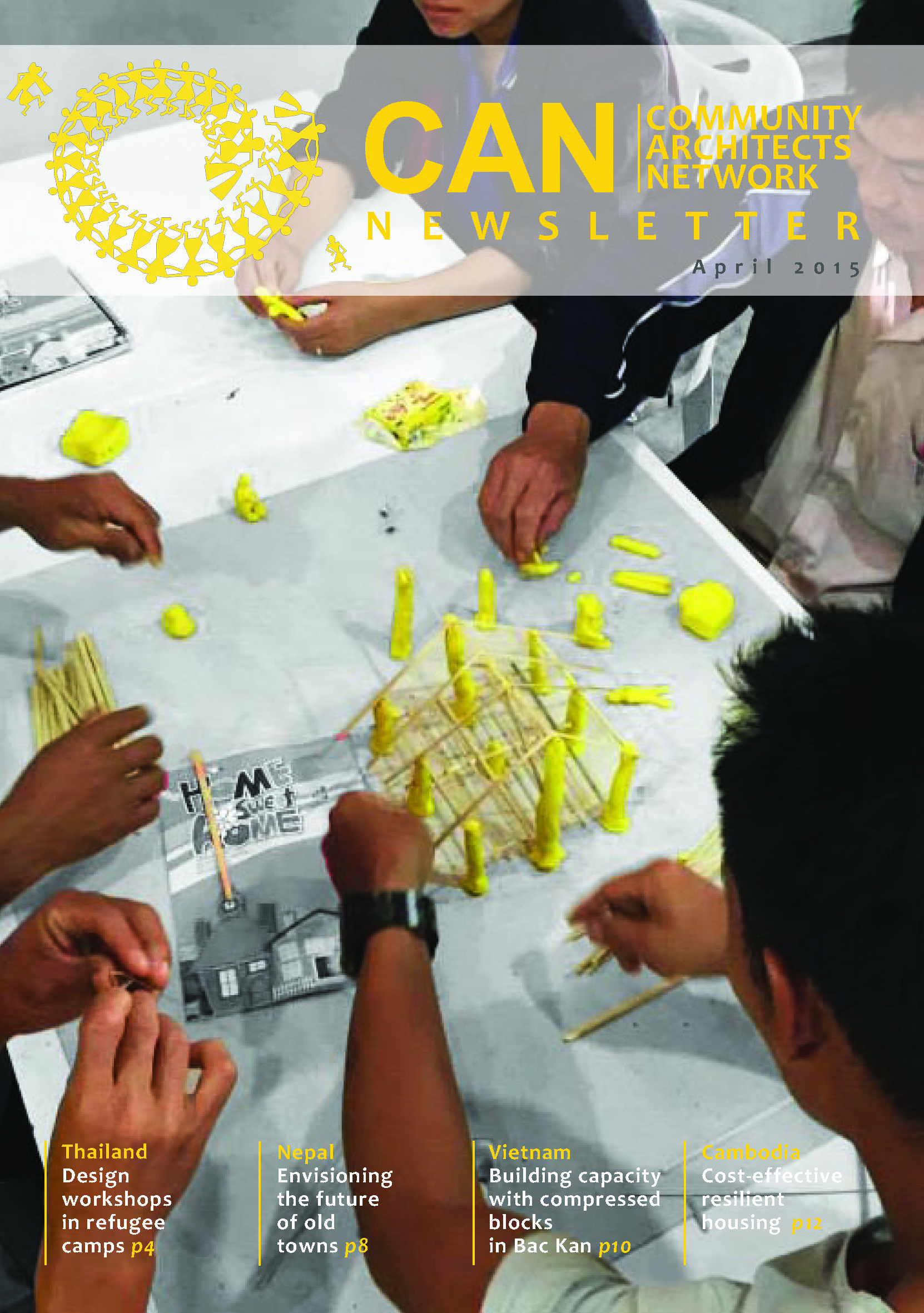
April 2015
CAN Newsletter April 2015
Size: 8370MB
Craftsmanship in architecture
We have come to the third issue of the CAN newsletter. Without intentionally creating a theme, unexpectedly a large number of stories arrived sharing on the role of craftsmanship in architecture at the scale of the household, and also the city. A week-long heritage conservation workshop hosted by friendsin Kathmandu, and a heritage tour launched by friends in Yogyakarta, both place the artisans themselves as the main actors in the upgrading process producing a form of “living heritage”. Young professional supported by the Perween Rahman Fellowship in Vietnam experiment with using compressed soil bricks as a low-cost alternative to concrete, while our friends from Hunnarshala, India share on their recent progress with rammed earth construction, and a new housing project for the homeless in Bangkok gives the space for residents to be the artisans of their own unit. The Siamese Association of architects has also decided to dedicate a public seminar to artisan-architects working, designing, and building with bamboo, rammed earth, and wood.
Hope you enjoy reading this collection of inspiring stories, please share with others, and please shareother stories with us.
We have come to the third issue of the CAN newsletter. Without intentionally creating a theme, unexpectedly a large number of stories arrived sharing on the role of craftsmanship in architecture at the scale of the household, and also the city. A week-long heritage conservation workshop hosted by friendsin Kathmandu, and a heritage tour launched by friends in Yogyakarta, both place the artisans themselves as the main actors in the upgrading process producing a form of “living heritage”. Young professional supported by the Perween Rahman Fellowship in Vietnam experiment with using compressed soil bricks as a low-cost alternative to concrete, while our friends from Hunnarshala, India share on their recent progress with rammed earth construction, and a new housing project for the homeless in Bangkok gives the space for residents to be the artisans of their own unit. The Siamese Association of architects has also decided to dedicate a public seminar to artisan-architects working, designing, and building with bamboo, rammed earth, and wood.
Hope you enjoy reading this collection of inspiring stories, please share with others, and please shareother stories with us.

January 2015
CAN newsletter January 2015
Size: 9015MB
This 2nd edition of the CAN newsletter starts with a special feature on Bangladesh, a country with a huge population and housing problem where the community architecture approach is still young but growing fast. Two big projects are now underwayin the country, seeking to apply the principles of participatory upgrading across Bangladesh’s lowincome communities. We also have some good examples of people and communities taking on an active role in maintaing and renovating their own houses, buildings and architectural and cultural heritage, in such different contexts as UNESCO heritage site George Town, the metropolis of Seoul, and the mountain city of Leh in Ladakh. From Thailand, we received a piece on how to apply‘universal design’ for people’s needs into community upgrading, and a beautiful story on land planning reform from the bottom up in the hilly Mae Tha district.
We are launching our new section ‘Beyond CAN’ to hear inspiring stories of change from other parts of the world, with two stories from Chile, where progressive government policies and innovative young architects are changing the way cities are made. We hope you’ll enjoy reading these stories and we strongly invite everyone to contribute to the newsletter, to help make it become a space for exchange and learning across the network and beyond.
We are launching our new section ‘Beyond CAN’ to hear inspiring stories of change from other parts of the world, with two stories from Chile, where progressive government policies and innovative young architects are changing the way cities are made. We hope you’ll enjoy reading these stories and we strongly invite everyone to contribute to the newsletter, to help make it become a space for exchange and learning across the network and beyond.
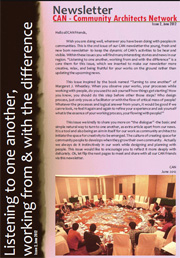
June 2012
Turning to One Another
Size: 1820MB
This issue inspired by the book named “Turning to one another” of Margaret J. Wheatley. When you observe your works, your processes while working with people, do you used to ask yourself how things get starting? How you know, you should do this step before other those steps? Who design process, just only you as a facilitator or with the flow of critical mass of people? Whatever the processes and logical answer from yours, it would be good if we can re-look, re-feel it again and again to refine your experience and ask yourself what is the essence of your working process, your flowing with people?”
12


